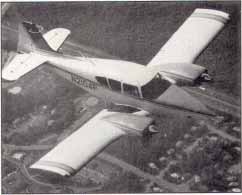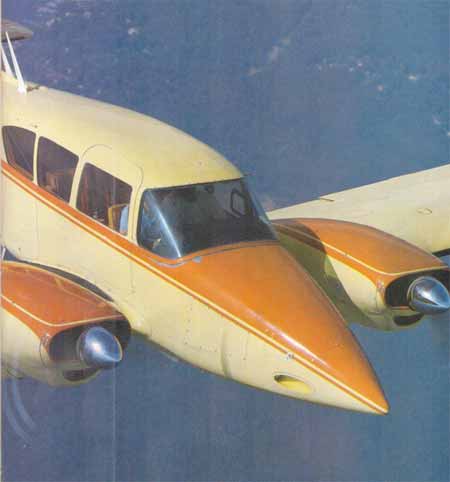PAGE TWO
 |
The Hoerner tips greatly
improve the Geronimo's slow speed handling |
Factory specs, verified by a long string of pilot reports, show the
single-engine ceiling has risen from 5200 ft to 12,000 ft and the single-engine
rate of climb is now 500 fpm where the original only had
180 fpm at sea level (if lucky). One of the factory's favorite demonstrations
has been to take the airplane off with one engine caged. Obviously
not a recommended procedure, this action certainly shows
a Geronimo is not an Apache.
The 60 percent cruise at 10,000 feet is reported by Seguin to be over
190 mph on only 17 gph, which isn't bad. The increased cruise speed
is nice. but the other performance increases are equally
important. For instance. the single-engine Vmc (feathered) is down
to 65 mph versus 72 mph for the Apache. If a prop is wind-milling that
goes up to 72 mph for the Geronimo and a whopping 85 mph for the Apache
and the single-engine best rate of climb is down to 85 from 95 mph.
This lets the Geronimo fly approaches at 85-90 mph without being in
a questionable operating environment. Slower approaches
mean shorter landing rolls, which are made even shorter by the dual
caliper brakes that can really drag the Geronimo down from speed in
a hurry.
A small number of Geronimos were made with the 170 hp 0-340 Lycomings
and one of them belongs to Henry Tienken of Lafayette, New Jersey.
Where we usually wind up cruising all over the countryside to find
airplanes to fly for pilot reports, in this case it meant walking out
my hangar door and across the runway to where Henry ties his Geronimo
down at Aeroflex-Andover Field in New Jersey.
Henry has owned his airplane for nearly six years and the purchase
was the result of looking long and hard for one. He was looking for
a twin that would give him the room and robust performance
of his old Navion when he stumbled across the Geronimo.
The plane had been donated to JAARS, the missionary jungle
fliers, who found the airplane really didn't fit their mission. But,
the Navion did. So, a little negotiating later, the airplane was on
its way to New Jersey.
Tienken's airplane is a full Geronimo conversion, meaning it has all
of the airframe and interior mods. It's not unusual to find an airplane
that has only as partial mod, maybe the engines and the nose but not
the interior or wings. Only the 170 hp engines keep his from being
absolutely full-boat. As such it can't take advantage of the gross
weight increase that comes with full conversion — his
is still 3500 lbs while a 180 Geronimo is 4000 pounds.
As would be expected, walk-around is typical Apache/light twin. The
airplane has no unusual features, other than peaking at the rudder
hinges, which is actually a holdover from the old Apache days when
the rudder took quite a beating during single engine training. The
Seguin people replace most of those parts during the conversion. They,
however, cannot get away from the periodic inspection and AD on the
propeller clamps.
It had been many years, 15 or more, since I sat at the controls of
an Apache of any variety and I had forgotten that the cabin is really
large and comfortable. If Henry was looking to replace his Navion with
anything of like size, he didn't have much choice — it had to
be a Geronimo (or maybe an Aztec). The perceived size of the cabin
has been noticeably increased by the simple addition of
the third window, which lets a lot of light into the back area where
the fifth seat hides.
The panel is so large that it's fortunate all the pilot-accessed controls
are well arranged because the pilot would really have to stretch to
get something on the other side of the panel. The Geronimo
panel is laid out along modern thinking, with the standard "T" pattern
and a sizable space (completely filled in Tienken's airplane) for the
central radio stack. Seguin couldn't do much with the placement of
the various air controls that hide down under the throttle quadrant.
Getting to those requires you already know where they are and can grab
them blind, or you lean down and squint.
The fuel system. hasn't been modified from the Apache and the control
panel still sits down between the seats, with the cross feeds locked
out by a little gate gizmo.
The trim is the old overhead crank system Piper was so in love with
in the 1950s, but there's a variation on a theme with two cranks mounted
on the same shaft — a short one for the rudder and a long one
for the elevator. The rudder trim is very logical, since cranking it
one way or the other is the direction you'd want the nose to move.
The elevator crank has potential for being initially confusing,
although it is clearly marked and, for reasons I can't explain, I didn't
once start the wrong way and then have to backtrack.
The Lycomings popped into life on the second blade, as the single starter
switch was toggled first left, then right. Pressures up, we headed
out toward the end of Aeroflex's 2000 ft runway.
I hadn't read the Geronimo literature prior to the flight, which turned
out to be a mistake. I didn't realize the airplane was being touted
as a semi-STOL airplane by virtue of its ability to get on and off
so quickly. Its stall speed is so much lower and the plane accelerates
so quickly, that Seguin usually advises getting the airplane off the
runway about 65 mph and hugging the ground until best single engine
climb speed is reached, a matter of only a couple of seconds.
Original Apache technique was usually to keep on the ground until at
least Vmc was reached because the airplane accelerated so slowly and
was so marginal if one should quit. Many pilots would hold the Apache
on until they had best single-engine climb speed. As it turns out Henry
still uses Apache technique, mostly because he doesn't have the 180
engines. From what I saw, I'd say the airplane could still be lifted
off and accelerate since it moves out much faster than an Apache and
accelerates in the air much faster than on the ground. Also, it takes
a fairly heavy hand to keep the Geronimo on the ground that long. As
soon as the yoke is lightened up, it literally leaps off the ground.
GO
TO NEXT PAGE
|



